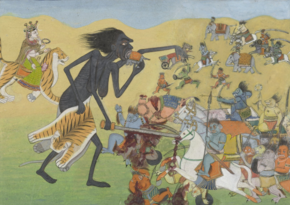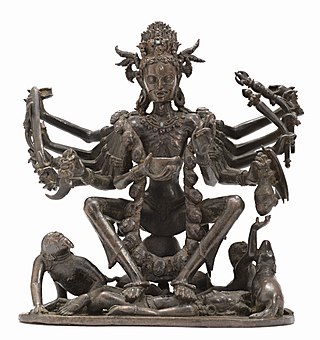
Chamunda, also known as Chamundeshwari, Chamundi or Charchika, is a fearsome form of Chandi, the Hindu mother goddess, aka Shakti and is one of the seven Matrikas.

Shakambhari, also referred to as Shatakshi, is a goddess of nourishment. She is regarded to be an incarnation of Mahadevi, and identified with both Lakshmi and Durga in Hinduism. After the malevolent asura Durgamasura deprived the earth of nourishment by causing the sages to forget the Vedas, the goddess appeared to offer human beings and devas sufficient fruits and vegetables to restore their strength.

Mahishasura is a bovine asura in Hinduism. He is depicted in Hindu literature as a deceitful demon who pursued his evil ways by shape-shifting. Mahishasura was the son of the asura Rambha and a she-buffalo named Mahisi. He was ultimately killed by the goddess Durga with her trishula (trident) after which she gained the epithet Mahishasuramardini.
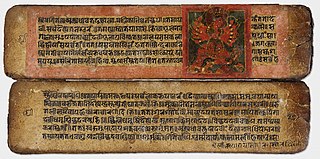
The Devi Mahatmya or Devi Mahatmyam is a Hindu philosophical text describing the Goddess, known as Mahadevi or Adishakti, as the supreme power and creator of the universe. It is part of the Markandeya Purana.

Chandi or Chandika is a Hindu deity. Chandika is another form of Mahadevi, similar to Durga. Chandika is a powerful form of Mahadevi who manifested to destroy evil. She is also known as Kaushiki, Katyayani, AsthadasabujaMahalakshmi and Mahishasuramardini.
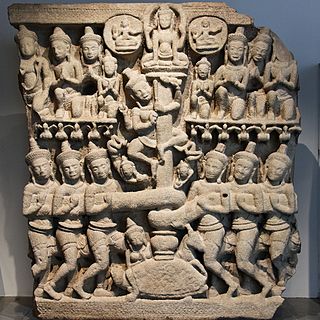
Hindu mythological wars are the wars described in the Hindu texts of ancient India. These wars depicted both mortals of great prowess as well as deities and supernatural beings, often wielding supernatural weapons of great power. Hindu teachings prescribe war as the final option, to be employed only after all peaceful methods are exhausted. Participation in righteous war, or dharmayuddha, was said to be honourable and was a principal duty of the Kshatriya or the warrior varna, and victory in such wars was regarded as a matter of honour.

Satyabhama, also known as Satrajiti, is a Hindu goddess and the third queen-consort of the Hindu god Krishna. Satyabhama is described as the incarnation of Bhudevi, the goddess and the personification of the earth. She aided Krishna in defeating the asura Narakasura.

Raktabīja is an asura in Hinduism. According to the Puranas, he fought with Shumbha and Nishumbha against the goddesses Kali and Chandi, both forms of Durga. Raktabīja secured from Shiva a boon according to which if one drop of blood from his body fell on the battlefield, many Raktabījas would arise from the blood and fight the enemies. Each of these Raktabījas would also be like the others in the matter of strength, form, and weapons.

Kali or Kalika is a major Hindu goddess associated with time, change, creation, power, destruction and death in Shaktism. Kali is the first of the ten Mahavidyas in the Hindu tantric tradition.

Shumbha (शुम्भ) and Nishumbha (निशुम्भ) are two asuras in Hindu mythology, featured in the Devi Mahatmya. In their legend, they were slain by the goddess Kaushiki.

Chandi Devi Temple, Haridwar is a Hindu temple dedicated to Goddess Chandi Devi in the holy city of Haridwar in the Uttarakhand state of India. The temple is situated atop the Neel Parvat on the Eastern summit of the Sivalik Hills, the southernmost mountain chain of the Himalayas. Chandi Devi Temple was built in 1929 by Suchat Singh in his reign as the King of Kashmir. However, the main murti of Chandi Devi at the temple is said to have been installed in the 8th century by Adi Shankaracharya, one of the greatest priests of Hindu religion. The temple also known as Neel Parvat Teerth is one of the Panch Tirth located within Haridwar.
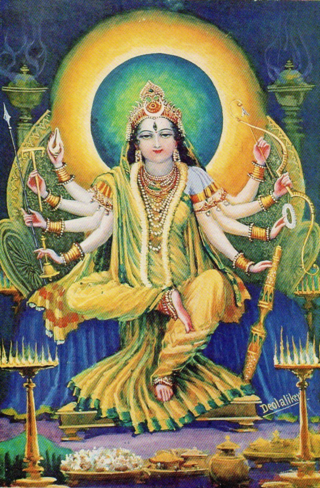
Kaushiki is a Hindu goddess, a deity who emerged from the sheath of Parvati. She was created before Parvati's conflict with the asura brothers Shumbha and Nishumbha, and was also the reason the Matrikas come into existence. According to the Lakshmi Tantra, Kaushiki is a manifestation of the goddess Lakshmi.

Kalaratri is the seventh of the nine Navadurga forms of the goddess Mahadevi. She is first referenced in the Devi Mahatmya. Kalaratri is one of the fearsome forms of the goddess.
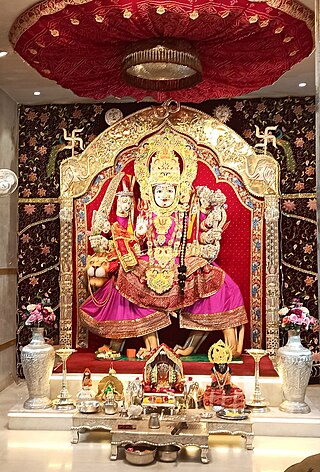
Yogamaya, also venerated as Vindhyavasini, Mahamaya, and Ekanamsha, is a Hindu goddess.
Rambha is an asura in Hindu mythology. Rambha and Karambha are asura brothers, born as the descendants of Danu and Kashyapa. When they were young, both decided to perform penance to get special powers to establish the rule of Danavas in the universe.

Mahagauri is the eighth form among the Navadurga aspects of the Hindu mother goddess Mahadevi. She is worshipped on the eighth day of Navaratri. According to Hinduism, Mahagauri has the power to fulfill all the desires of her devotees.

Bhramari is the Hindu goddess of bees. She is an incarnation of the goddess Adi Shakti in Shaktism, and is primarily regarded to be a form of Lakshmi in the Pancharatra texts, but is also regarded to be a form of Parvati in Shaivism.

Mahakaali — Anth Hi Aarambh Hai is an Indian television series that premiered on 22 July 2017 on Colors TV. The show traced the epic story of Goddess Parvati’s metamorphosis into Mahakali. Produced by Siddharth Kumar Tewary's Swastik Productions, it starred Pooja Sharma in the title role of Goddess Mahakali, Sourabh Raj Jain as Lord Mahadev and Kanan Malhotra as Lord Vishnu.
Devi Adi Parashakti is a mythological television series based on the Hindu texts of the Shiva Purana, the Devi-Bhagavata Purana, the Markandeya Purana, and pan-Indian folktales of the Goddess. The series was created by Siddharth Kumar Tewary, directed by Loknath Pandey and Manish Singh, and produced by Swastik Productions. Rati Pandey plays the role of Devi Adi Parashakti and her incarnations Goddess Sati, and Goddess Parvati. Tarun Khanna played the role of Devi's husband, Lord Shiva with Kanan Malhotra as Lord Vishnu, Devi's brother. The show also features Sonia Singh as Goddess Diti, the main antagonist.
